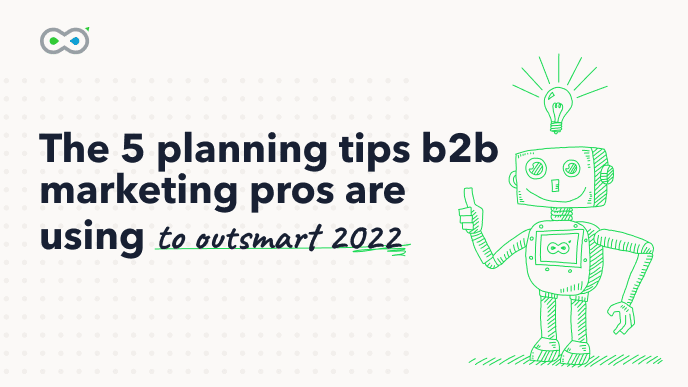There’s a very famous line from the hit HBO TV series Game of Thrones (let’s not mention season 8) which goes like this:
Lannister, Targaryen, Baratheon, Stark, Tyrell, they’re all just spokes on a wheel. This one’s on top, then that one’s on top, and on and on it spins, crushing those on the ground.
Queen Daenerys Targaryen
I’m not going to stop the wheel, I’m going to break the wheel.
As far as B2B Marketing goes, 2020 well and truly broke the wheel. All our playbooks, our plans, our fancy forecasting models – everything went into the dustbin. The status quo is dead and buried.
Market instabilities have characterized the last three years – 2020 was about companies adapting to the pandemic, 2021 was about businesses adapting to the pandemic recovery, H2 of 2022 is about companies adapting to a bear market.
All good planning takes historical data into account, but what do you do when all your historical data becomes useless? Like in our case where 2020-2022 data is useless for any planning in 2023.
So how do you keep your marketing relevant and effective? Well, agility in reading the market and course-correcting accordingly is gonna be key. But, as always there’s a lot more to it than that.
We’ve put together 5 key actions that you can take to keep your B2B marketing planning effective throughout 2023.
Here goes..
1. Create Alternate Scenarios To Stay Prepared For Whatever’s Coming.
If you’re driving from Youngstown, Ohio to Pittsburgh, PA, Google Maps gives you a choice of 3 alternate routes. Think about it. 3 alternate routes for a drive which takes only about an hour or so.
But for your marketing planning which is meant to drive the B2B marketing for your company for the entire year, you likely have only one master plan.
- What are your fallback options?
- What happens if you need to cut 50% of your budget, what happens if you won’t grow your team?
- What if the product demand goes up? What if it drops?
- Does your plan have the inbuilt ability to cater to hundreds of possible scenarios?
- What if marketing prices shoot up for a particular channel?
Do you have alternative “routes” for all these scenarios? So our first tip for you is – have multiple alternate scenarios to use when things change – as they will.
Start with the most likely scenario (based on current market trends) – lower conversion rates. You and your competitors will be fighting for fewer opportunities as companies cut back on acquiring new tech.
2. React Fast To Changes.
2020 was pretty much a poster year for the saying, “Nothing is permanent except change.” When COVID lockdowns hit, businesses jumped towards digital platforms at a crazy rate.
All of a sudden, you had a ton of people working from home, virtual conferences became the norm and e-commerce went through the roof. Just to look at one example –
Team communication and collaboration company Slack revenues went up from $630 million in FY20 to $902 million in FY21.

Source: Business Of Apps, Slack
Similarly, Atlassian (the company behind Jira, Trello, and Confluence) showed a revenue of $569 million for Q4 2021 which is an increase of 38.18% year-over-year (Source: Macrotrends).
With lockdowns and associated WFH challenges, many B2B SaaS companies found great opportunities. Marketing had to quickly step up to deal with the change as well.
On the other side, 2022 started out with growth plans that were expected to continue the trend of the past two years. But as inflation rates went up, and the fed started raising interest rates, we saw the opposite trend – companies had negative growth rates, some for the first time in over a decade.
Our main lesson from those two opposite years: don’t be afraid to reallocate budgets as new marketing channels or opportunities disappears. This is especially true for social media where today’s fad is tomorrow’s trend. You never know where the next big thing is coming from.
3. Review And Adapt Your Plan Every Month.
Source: Marketoonist
When you are driving on a steep mountain road, the first thing you do is – slow down.
B2B Marketing planning in 2023 will exactly be like driving up a mountain road – full of twists and turns and with the added fog of uncertainty to make things even more challenging.
So the first thing that you need to do is – ditch that year long marketing plan. Now is not the time to go all-in on a long-term plan. Committing to a long term plan in 2023 is as bad as pushing the pedal to the metal in fifth gear on a mountain road.
As the current market changes affect conversion rates, all the data from 2022 won’t matter. And older data will be even more out of date because of the changes in speed and scaling rates of B2B SaaS.
This does not mean that you don’t plan at all. Your B2B marketing plans need to be short term so that you can quickly course correct. But more importantly, it needs to be flexible enough so that you can react to the changes in the market.
You need to create a process to review and adapt the plan every month so that the marketing stays dynamic to take advantage of the opportunities that come up.
4. Account For Time-to-impact.
Time to put on our geek hats and talk metrics…
Time to Impact is a calculation of the time from the moment a user interacts with a brand and until they convert. It’s not a very well-known metric but we really like this one here at Infinigrow.
You can calculate TTI by exporting your customer data along with the dates of every interaction, and then creating a pivot table to measure each channel’s average time between interaction and conversion.
Why is it so important to measure TTI?
Glad you asked…
B2B marketing is a long game. Many marketing plans or channels often take months to generate a positive ROI. But in 2023, you may have to quickly switch to marketing channels that generate quicker revenue.
Let’s say one channel takes 1 year to generate 4x revenue but it reaches positive ROI after 8 months. Another channel takes one year to get to just 3x ROI, but it gets to positive ROI after just 2 months. So, while channel #1 definitely gives you a higher ROI overall, channel #2 is already running a profit in one-fourth of the time. In other words, Channel #1 has a high overall ROI but Channel #2’s Time to Impact is much shorter.
Which leads us to the key takeaway –
For long term growth, high overall ROI with low TTI may be a good option but with the uncertainty that we’ll all be facing in 2022, you should probably focus on improving your TTI. This will get you fast results and as the money comes in, you can scale your budget.
5. Invest In Your Data Infrastructure
Data!data!data!” he cried impatiently. “I can’t make bricks without clay.
Sherlock Holmes
All of the above action steps need one vital ingredient – data. It’s the glue that holds it all together.
And not just random, disorganized and disconnected data sets either.
- You need data from all your channels and you need it to be up to date.
- You’ll need the supporting infrastructure to actually make sense of this data.
- You need a clean, consistent data structure that lets you spot trends, run analytics, and highlight fleeting opportunities as they pop up.
Investing in a solid data infrastructure will be the most critical piece of the puzzle for marketing in 2022. Everything is built on this foundation.
Conclusion
2023 will be different from 2020, 2021 and 2022, it will be different from every other year in the history of marketing. Never before have we had such an abundance of data combined with constant market changes that force you to constantly change and adapt your marketing efforts.
Use the ideas in this article when planning and executing your marketing plan for 2023, to be sure you’ll hit your revenue goals.



